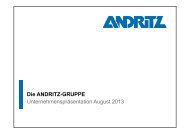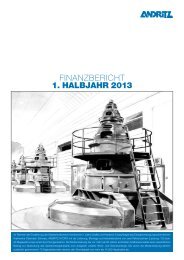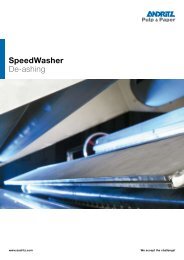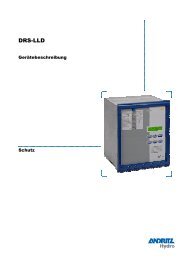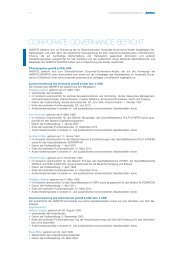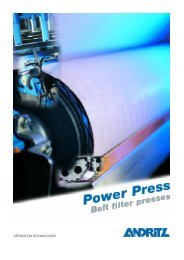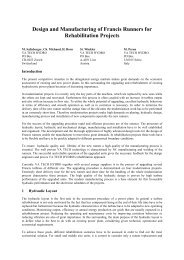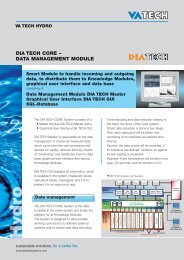2004 - ANDRITZ Vertical volute pumps
2004 - ANDRITZ Vertical volute pumps
2004 - ANDRITZ Vertical volute pumps
You also want an ePaper? Increase the reach of your titles
YUMPU automatically turns print PDFs into web optimized ePapers that Google loves.
Digester<br />
A pressure vessel, typically cylindrical used to<br />
treat wood chips or other cellulosic materials with<br />
chemicals under elevated pressure and temperature,<br />
so as to produce pulp for papermaking.<br />
DIP<br />
Deinked Pulp. Pulp produced from deinked<br />
wastepaper, like old newsprint and old magazines.<br />
Most DIP is used in integrated paper mills, but<br />
some is sold on the market, in which case it is<br />
usually dried or wet-lapped.<br />
Dispersion<br />
A process stage in the treatment of recycled<br />
fibers. Several process stages are needed to<br />
remove the impurities (e.g. glue, ink) from the<br />
fibers. It is impossible, however, to eliminate all<br />
impurities. Dispersing reduces these particles to<br />
such a small size that they are no longer detrimental<br />
to paper quality.<br />
ECF<br />
Elemental Chlorine-Free pulp. Pulp bleached<br />
without the use of any elemental chlorine. However,<br />
chlorine compounds (e.g. chlorine dioxide) may be<br />
used in the bleaching process.<br />
EPC<br />
Engineer-Procure-Construct. A project delivery<br />
where one supplier assumes total responsibility for<br />
product and project engineering, equipment and<br />
construction procurement, and on-site construction.<br />
Extrusion<br />
A continuous process in which animal feed<br />
components are cooked under pressure in a<br />
combination of frictional and steam heat in order<br />
to expand the resulting product and convert it into<br />
feed granulate. This process is very common in<br />
production of pet food, fish feed, and cereals.<br />
Fiberline<br />
The machines and process systems involved in<br />
converting wood chips into pulp. Process steps<br />
can include cooking, washing, screening, knot<br />
separation, refining, and, if required, bleaching.<br />
Grade<br />
A class or level of quality of pulp or paper which<br />
is distinguished from other pulps or paper on the<br />
basis of its use, appearance, quality, manufacturing<br />
history, raw materials, or a combination of<br />
these factors.<br />
TECHNICAL GLOSSARY<br />
Green liquor<br />
Aqueous solution of the smelt resulting from the<br />
burning of thickened waste liquor in the recovery<br />
boiler. Mainly consists of sodium carbonate and<br />
sodium sulphide.<br />
GSM<br />
Grams per Square Meter, or g/m 2. A measure of<br />
the basis weight of paper and board, or its grammage.<br />
Hammermill<br />
Machine used for pulverizing raw materials for<br />
various applications including animal feed and<br />
preconditioning for refining applications; the raw<br />
materials are hammered by a series of steel hammers.<br />
The pulverized material exits through a<br />
screen plate with apertures. The size of the apertures<br />
and hammers, including the number of hammers,<br />
can be changed to achieve desired results.<br />
HC<br />
High Consistency. Pulp suspension with a consistency<br />
of 18–40%.<br />
Headbox<br />
Located at the wet end of a paper machine,<br />
the headbox delivers a uniform jet of paper slurry<br />
(furnish or stock) having essentially the same width<br />
as the paper web to be produced. The word is<br />
derived from earlier days when the hydrostatic<br />
head within the box was sufficient to deliver a jet<br />
velocity matching the speed of the forming fabric.<br />
Today, the pressure within a modern headbox is<br />
maintained by <strong>pumps</strong> and controls.<br />
Hexenuronic acid<br />
Acid formed during chemical pulping that reacts<br />
with several bleaching chemicals, thus increasing<br />
their consumption. The elimination of hexenuronic<br />
acid reduces the need for bleaching chemicals and<br />
lowers the production costs of bleached pulp. It<br />
also helps to keep the pulp’s brightness longer.<br />
Kraft pulp<br />
The Kraft process is the world’s predominant<br />
chemical pulping process because of the strength<br />
of pulp it produces. The process involves cooking<br />
(digesting) wood chips in an alkaline solution,<br />
where the active cooking agent is a mixture of<br />
sodium hydroxide and sodium sulphide. The dis-<br />
<strong>ANDRITZ</strong> <strong>2004</strong><br />
121






